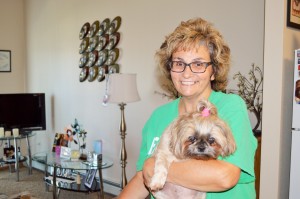
FirstHome program user Teresa Sayler (right) relied heavily on Gena Syvertson (left) of REMAX Legacy Realty to find the right home and negotiate the terms of the sale.
While many young adults wait until they are married or involved in a long-term relationship before pursuing homeownership, Teresa Sayler knew having her own home was what she wanted.
Sayler moved to Fargo, ND, for college and stayed on after graduation. She lived in apartments for a dozen years, a situation that to her always felt temporary. At 30 years of age, Sayler was ready to be grounded.
Turns out while buying on her own was a little nerve racking, “I had to remind myself to take things one step at a time,” Sayler isn’t alone in following that path. After married couples, the National Association of Realtors ranks single women, age 18 to 34, as the second largest home buying group in the United States making up 15 percent or more of the market each year.
“Single females often are heading out of their own at an earlier age to establish their households,” says Jessica Lautz, NAR’s managing director of survey research and communications. Men purchase on their own half as often.
Taking full advantage of available resources helped Sayler ease her solo purchase anxiety. In addition to taking a homebuyer education class, she talked to a financial advisor and took a class focused on budgeting, paying down debt and building savings. Sayler also visited with family and friends to learn about their experiences. When she was confident that she was really ready, Sayler sat down with a lender.
Clayton Lilleby of First Community Credit Union pre-qualified Sayler for North Dakota Housing Finance Agency’s FirstHome™ program and referred her to the person she relied on heavily to find the right home and negotiate the terms of the sale, Gena Syvertson of REMAX Legacy Realty.
A real estate agent for more than a dozen years, Syvertson has a soft spot for first-time buyers. She enjoys educating them, stepping them through the purchase process, and making sure they understand the terms being used. She reminds them to ask questions too so they are comfortable with the decisions they are making.

While Teresa Sayler isn’t afraid of taking on home improvement projects, her real estate agent encouraged her to have a home inspection and include an inspection clause in the purchase agreement so if major repairs were needed, they could be addressed before closing. Doing so gave Sayler peace of mind that her new home would be structurally sound.
“Before looking at any homes,” said Syvertson, “Teresa and I sat down and we talked about home features she really needed versus things she might want to have and what the tradeoffs might be.”
Initially, Sayler wasn’t interested in a twin home, but she knew she wanted an attached garage to better endure North Dakota’s cold winters. A large outdoor space was another priority, so she could have a garden, more privacy, and have friends over to sit around a firepit on summer evenings.
Helping Sayler narrow down her list of must-haves and understand the improvements that could be made after a home was hers really helped. “I only physically looked at about four or five homes before I found one that I made an offer on,” Sayler said.
While Sayler wasn’t afraid of taking on some projects, Syvertson encouraged her to have a home inspection and include an inspection clause in the purchase agreement so if major repairs were needed, they could be addressed before closing. Doing so gave Sayler peace of mind that her new home would be structurally sound.
While Sayler now takes pride in being a homeowner, she’s only talked to a few friends about buying. When the subject comes up, she doesn’t immediately push them into homeownership.
“If they think it’s what they want, I encourage them to educate themselves, to talk to a real estate agent and make sure their finances are in order. Don’t buy a home just because everyone else is. Forget about everything you see on Pinterest, and what your family and friends are saying and doing, is it right for you?”








